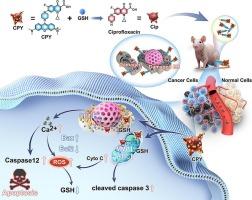基于线粒体和内质网双靶向释放环丙沙星的化疗
IF 4.7
2区 医学
Q1 BIOCHEMISTRY & MOLECULAR BIOLOGY
引用次数: 0
摘要
细胞器靶向药物代表了下一代精确化疗。为了实现这一点,一个特定的细胞器靶向组对于各种纳米药物和前药是必不可少的。同时靶向多个细胞器可以降低药物剂量,减少副作用,并可能通过细胞器间的同步作用改变药物的作用机制,从而提高药物疗效。然而,设计一个能够将药物输送到多个细胞器的分子平台仍然具有挑战性,这阻碍了精确化疗的发展。在这里,我们通过共价键将pyronine单元作为战斗部偶联到抗生素(环丙沙星,Cip)上,开发了一个称为CPY的分子平台。该平台同时靶向线粒体(Mito)和内质网(ER),通过谷胱甘肽介导的SNAr途径原位释放Cip。在异种移植肿瘤模型中,CPY诱导肿瘤细胞凋亡并表现出抗肿瘤活性。这些结果证明了将传统的非抗肿瘤药物转化为化疗药物的可行策略。本文章由计算机程序翻译,如有差异,请以英文原文为准。

A chemotherapy based on dual-targeted release of ciprofloxacin in mitochondrial and endoplasmic reticulum
Organelle-targeting drugs represent the next generation of precision chemotherapy. To achieve this, a specific organelle-targeting group is essential for various nano-medicines and prodrugs. Simultaneously targeting multiple organelles enhances drug efficacy by enabling lower dosage, minimizing side effects, and potentially altering the action mechanism of drugs through synchronous effects across organelles. However, designing a molecular platform capable of delivering drugs to multiple organelles remains challenging, which hinders the advancement of precise chemotherapy. Here, we conjugated a pyronine unit as a warhead to an antibiotic (ciprofloxacin, Cip) via a covalent linkage, developing a molecular platform termed CPY. This platform simultaneously targets mitochondria (Mito) and the endoplasmic reticulum (ER), releasing Cip in situ through a glutathione-mediated SNAr pathway. CPY induced apoptosis in tumor cells and exhibited anti-tumor activity in a xenograft tumor model. These results demonstrate a feasible strategy for repurposing conventional non-antitumor drugs into chemotherapeutic agents.
求助全文
通过发布文献求助,成功后即可免费获取论文全文。
去求助
来源期刊

Bioorganic Chemistry
生物-生化与分子生物学
CiteScore
9.70
自引率
3.90%
发文量
679
审稿时长
31 days
期刊介绍:
Bioorganic Chemistry publishes research that addresses biological questions at the molecular level, using organic chemistry and principles of physical organic chemistry. The scope of the journal covers a range of topics at the organic chemistry-biology interface, including: enzyme catalysis, biotransformation and enzyme inhibition; nucleic acids chemistry; medicinal chemistry; natural product chemistry, natural product synthesis and natural product biosynthesis; antimicrobial agents; lipid and peptide chemistry; biophysical chemistry; biological probes; bio-orthogonal chemistry and biomimetic chemistry.
For manuscripts dealing with synthetic bioactive compounds, the Journal requires that the molecular target of the compounds described must be known, and must be demonstrated experimentally in the manuscript. For studies involving natural products, if the molecular target is unknown, some data beyond simple cell-based toxicity studies to provide insight into the mechanism of action is required. Studies supported by molecular docking are welcome, but must be supported by experimental data. The Journal does not consider manuscripts that are purely theoretical or computational in nature.
The Journal publishes regular articles, short communications and reviews. Reviews are normally invited by Editors or Editorial Board members. Authors of unsolicited reviews should first contact an Editor or Editorial Board member to determine whether the proposed article is within the scope of the Journal.
 求助内容:
求助内容: 应助结果提醒方式:
应助结果提醒方式:


